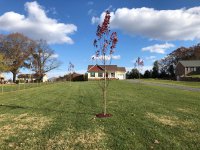I recently bought and planted 3 October Glory Red Maple trees. Each tree was previously in 25 gallon containers. I live in central NC where we have very hard/dense clay soil. The holes were dug deep enough and I backfilled with plant food and fertilizer and I put mulch on top.
But once the trees were planted, I realized that I should've made the holes twice the diameter of the 25 gallon containers from which each October Glory Red maple came out of. Instead my hole sizes were probably only 6 inches (on average) wider than the diameter of the pots from which the trees came out of.
So here are my questions. Will these trees likely decline over the next couple of years due to me not making the holes big enough? Should I go back and amend the soil farther out from the tree, or will the roots likely still find their way through the dense clay soil?
Thanks for any feedback here. If I need to take further action, I will probably (try) to get a tree company to help as I had a very difficult time getting the holes dug in the first place (with my shovel). Landscaping companies obviously have much better equipment for tackling a job like this, especially trees of this size that are placed in clay soil.
But once the trees were planted, I realized that I should've made the holes twice the diameter of the 25 gallon containers from which each October Glory Red maple came out of. Instead my hole sizes were probably only 6 inches (on average) wider than the diameter of the pots from which the trees came out of.
So here are my questions. Will these trees likely decline over the next couple of years due to me not making the holes big enough? Should I go back and amend the soil farther out from the tree, or will the roots likely still find their way through the dense clay soil?
Thanks for any feedback here. If I need to take further action, I will probably (try) to get a tree company to help as I had a very difficult time getting the holes dug in the first place (with my shovel). Landscaping companies obviously have much better equipment for tackling a job like this, especially trees of this size that are placed in clay soil.


